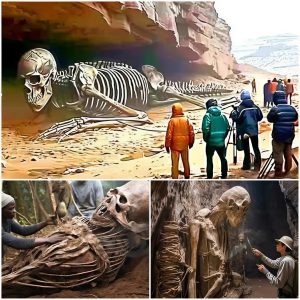In the arid landscapes of Namibia, a discovery has been made that could rewrite the history of Africa and perhaps the world. Archaeologists have unearthed the remnants of a colossal civilization, buried under layers of sand and time, revealing a lost society that defies all previous understanding.

The Discovery
The first signs of this ancient civilization emerged in the remote Damaraland region, where a team of archaeologists stumbled upon a series of massive stone structures. Initially thought to be natural formations, closer examination revealed the unmistakable hand of human craftsmanship. These structures, some towering over 30 feet high, suggest the existence of a society capable of architectural feats previously unheard of in Africa.
A Civilization of Giants?
The most astonishing aspect of this discovery is not just the size of the structures, but the tools and artifacts found within them. Gigantic stone tools, too large for a normal human to wield, were discovered alongside the ruins. This has led some researchers to propose a controversial theory: that the civilization was inhabited by people of extraordinary size.
While the idea of giants may seem far-fetched, the evidence is compelling. Human remains, although fragmentary, have been unearthed, with bone structures far larger than those of modern humans. Could these have been the giants of ancient legend, whose existence has long been dismissed as mere myth?

Technological Marvels
In addition to the massive tools, the site has yielded a treasure trove of technological marvels. Intricately carved stone tablets suggest a written language, yet to be deciphered. The precision of these carvings indicates a level of sophistication and knowledge that challenges the timeline of technological development in human history.
Moreover, remnants of advanced irrigation systems have been found, suggesting that this civilization had mastered agriculture in an unforgiving landscape. The scale and complexity of these systems indicate that they supported a large population, thriving in what is now a desert.
A Global Connection?
The discovery has sparked intense debate among historians and archaeologists. Some believe that this civilization could have been part of a larger, interconnected world, with trade routes extending far beyond Africa. Artifacts resembling those found in ancient Mesopotamia and the Indus Valley have been uncovered, suggesting that this Namibian civilization might have had contact with distant cultures.
The Mystery Deepens
Despite the wealth of artifacts, much about this civilization remains a mystery. Who were these people? What led to their rise and eventual disappearance? And why have they been forgotten by history?
The excavation is ongoing, and each new discovery raises more questions than it answers. As researchers continue to unearth the secrets of this lost world, the true story of Namibia’s giants may finally come to light.
A Call for Preservation
The Namibian government, along with international organizations, has recognized the importance of this site. Efforts are being made to preserve the ruins and protect them from looters and the elements. There is hope that, with careful study, this lost civilization will finally receive the recognition it deserves.
A New Chapter in History
The discovery of Namibia’s ancient giants is more than just a historical curiosity; it challenges our understanding of the past. As researchers delve deeper into the mysteries of this lost world, they are not only unearthing the remnants of a forgotten people but also reshaping the narrative of human civilization.
The sands of Namibia may have hidden this ancient society for millennia, but now, as the truth emerges, the giants of Namibia stand tall once again, reminding us that the history we know is just the beginning.





